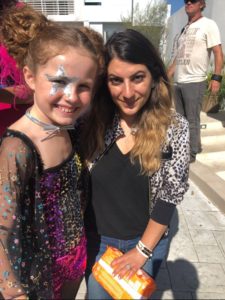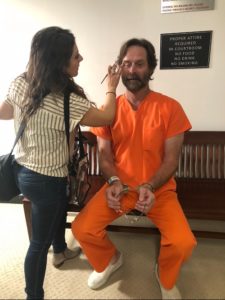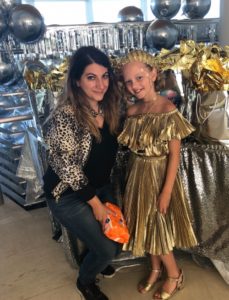Having completed its second season, HBO’s series Big Little Lies, created by David E. Kelley, is nominated for a Primetime Emmy for Outstanding Contemporary Makeup, for its fourth episode, “She Knows.” Makeup department head Michelle Radow, who has been in charge of the show’s makeup for all of Season Two, was among the nominees.

Steve Artmont supervised Big Little Lies’ makeup department for Season One, and Radow worked in the department for all seven episodes, eventually becoming the key makeup artist, second in command to the department head. Then, Andrea Arnold, who directed all seven episodes of Season Two, brought Radow in for an interview and hired her to be season two’s makeup department head. Significantly, Radow had also worked as a make-up artist with Jean-Marc Vallée, director of all seven episodes of Big Little Lies’ first season and all eight episodes of HBO’s limited series Sharp Objects. “Nobody thought it would be coming back,” Radow said of Big Little Lies’ second season, adding that Vallée presumed that the show would be a one-season limited series.
Notably, Big Little Lies stars six of the top women working in movies and television: Nicole Kidman, Reese Witherspoon, Shailene Woodley, Laura Dern, Zoe Kravitz, and Meryl Streep. With regards to makeup, those top six ladies all had in their contracts that they were able to bring in personal makeup artists, who typically stay with the star from project-to-project, including interviews, personal appearances, and public events. Speaking as department head, Radow explained that every star should indeed have had a personal makeup artist who solely attended to one actress. “There’s so much to do as a department head. I was so blessed—HBO gave us whatever we needed to make the makeup department run smoothly. We all worked really well together; I knew a lot of them from Season One.”
While the six main actresses each had their own makeup artist, Radow was integrally involved in creating all of Season Two’s make-up concepts and their appearances for each episode. “I go through the show scene-by-scene and disperse the information to the team,” Radow detailed. “We were a pretty well-oiled machine.”

In the Big Little Lies makeup department, Radow established four places where artists were creating makeup and hairstyles: three makeup trailers, plus a fourth trailer, which was actually Streep’s personal trailer that doubled as her makeup and hairstyling station. To execute the series’ makeup, Radow hired 11 full-time makeup people, eight of whom were the aforementioned personal artists—two of those were secondary artists who served to back up the primary artists. In an exception, a makeup union agreement allowed the makeup artists for Woodley and Streep to also create those actresses’ hairstyles; the other four major women had their own separate hairstylists on the show.
When Radow began work on season two, she was issued the majority of the teleplays for the run of the show. “I read everything, scene by scene, to break it down,” Radow described. “I made Excel grids with all of the characters, what’s happening with them, what time of day it is. The team can come in at any time and see my printed-out Excel grids. There’s also a production meeting, sometimes two, to go over the director’s vision and the logistics.”
Given that all seven Big Little Lies episodes were photographed simultaneously, nothing on the schedule was shot in sequence. In addition to the principal women, the show featured 150 supplementary cast members, mandating that Radow maximize her efficiency in managing all of season two. “In between being on-set and creating the other looks, I am doing makeup tests and sending them in to the director,” she remembered, adding that this series also has ‘special’ makeup needs. “I am also running the effects department, getting approvals, sending actors to get impressions of teeth done and life-casts, scheduling the prosthetic tests, and getting them approved.”
For the nominated “She Knows” episode, one which had a 1970s disco-era sequence, Radow enlisted 18 additional makeup artists to work on two groups of 40 children each that were rotated in, given the limited shooting availability of minors. “I asked production for a trailer called a ‘lunch box,’” Radow said of a mobile facility used on remote locations, protected from outdoor elements. “The whole thing was to be my background makeup station. I had two seven-feet long tables together with six artists doing face painting. In the back, there were six artists doing 70s glam. Plus, I had a 70s facial hair-laying station for sideburns and moustaches.”

As she was responsible for the looks of 80 children in the episode, Radow maintained a consistency of makeup artist and performer. Continuity photos were taken on an iPad Mini, and a cleanup crew was brought in at the end of each day to remove the face painting from the child actors.
In total, the Big Little Lies production unit shot for six-and-half-months to cover all seven episodes of season two, from mid-March to mid-August of 2018. Stage work was done at The Lot on Santa Monica Boulevard in Los Angeles, while a school location was photographed in Brentwood and seven weeks of filming occurred at exterior locales in Monterey, California. Prior to the production period, Radow had two-to-three weeks of prep time. “You are also prepping as you go,” she revealed, “leaving set to go to a production meeting, running to the Fractured FX effects shop.”
Though Season Two of Big Little Lies was a critical and viewership success, Radow stated that she attempted to bring the same effort to this project as she does on all of her shows. “My job as a department head is to make sure the makeup department runs smoothly and flies under the radar,” she stated, noting that control and regimentation are critical. “I don’t want the department to be the topic of conversation with production. My key, Erin Rosenmann, and I try to be so organized, to the point where we don’t even have to talk to you, and you will know what you are doing. I try to give each artist all the information, so they are empowered to be creative. Everybody’s equal—we are all a team.”





